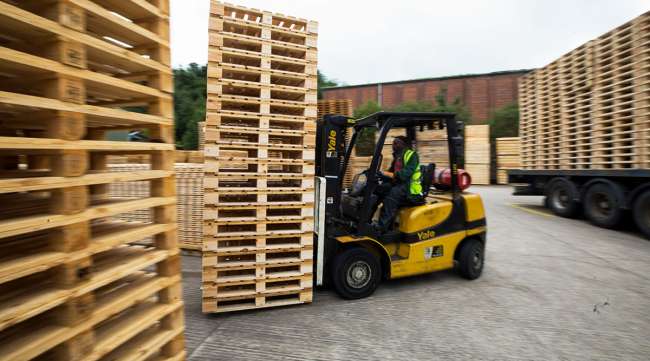Star Tribune
Pallet Makers Hit by Supply Shortages as Demand Rises

[Stay on top of transportation news: Get TTNews in your inbox.]
Just about everything in your home traveled on a wooden shipping pallet.
In our worldwide economy, the humble pine pallet is the way that goods move around the globe. Demand for pallets is so great that American manufacturers churn out nearly 1 billion of them every year.
And right now, it’s not enough.
A worldwide shortage of pallets threatens to put a crimp in the flow of consumer goods, from tomatoes to toothpaste to toasters. Prices have doubled in the past year, and makers can’t keep up with demand.
“I think it’s a perfect storm,” said Al Raushel, one of four brothers who own Savanna Pallets in McGregor, Minn. One of the Midwest’s largest pallet manufacturers, Savanna turns out more than 10,000 pallets a day.
“There’s a trucking shortage,” Raushel said. “We’re struggling to find people to staff our operations, and we’re having some trouble getting material into our facilities.”
The problem, Raushel and others said, is linked to a surge in the economy as the COVID-19 pandemic dies down. Companies of all kinds slowed their operations last year as the pandemic forced restrictions on activity.
Now, as business begins to pick up, sawmills aren’t staffed. Some truckers are on the sidelines. Korean nail factories are running months behind in filling orders.
And pallet makers often are bidding for scarce wood against homebuilders. Result: The price of wood, in some cases, has tripled. Bottom line, a new pallet that sold a year ago for $12 to $14 now costs $25 to $28.
“There just isn’t enough [wood] to go around,” said Tim Logan, owner of Viking Pallet in Maple Grove, Minn. “It’s just a constant headache.”
Logan spends much of his time these days trying to find wood, trucks, nails and workers.
“You’re just running from crisis to crisis,” he said. At least Logan doesn’t have to worry about finding customers. Viking Pallet is turning away new accounts in order to be sure it can take care of its existing customers.
Pallets are a relatively new invention, dating from the 1930s. In recent decades, they’ve become the standard for shipping consumer goods. Pallets lend themselves to automation, saving time and money for the companies that use them.
According to the National Wood Pallet and Container Association, pallets are used by 93% of all companies that handle materials.
“I can’t think of much that’s produced in our country right now that’s not shipped on pallets,” said Rob Schultz, vice president of business development at J&B Pallet in Lake City, Minn.
“Unfortunately, it’s gonna affect everything.”
Not everyone is feeling the shortage. C.H. Robinson, the Eden Prairie, Minn., company that’s the world’s largest shipper of truckload freight and ranks No. 1 on the Transport Topics Top 50 list of the largest logistics companies in North America, has kept up so far, although it has lined up a second pallet source just in case.
“A month ago the pallet shortage was challenging, but now it is in a better place,” said Greg West, the company’s vice president of North American surface transportation. “While we’ve seen some shortages, our primary pallet producer is keeping up with demand.
“It is difficult to predict what it will look like next month,” West added. “When the pandemic hit, lumber companies cut production, and then business came roaring back at double digits. That means that supply was tight, whether you were making pallets or furniture or even building houses.”
For now, pallet producers in Minnesota and elsewhere will keep scrambling, hoping to get out in front of the surge.
Raushel said with a sigh, “We would like to see a level of normalcy.”
Want more news? Listen to today's daily briefing below or go here for more info:
Distributed by Tribune Content Agency, LLC

